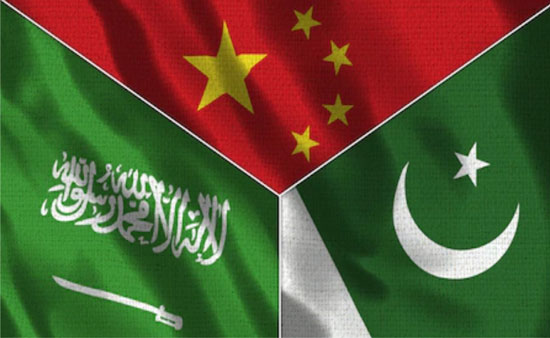Maira Hilal
CHINA-Pakistan Economic Corridor (CPEC) is a conscious effort to achieve cooperation in different fields including defence, trade, energy, science and technology. In the present research article, benefits of CPEC for Saudi Arabia have been discussed in detail as well as the present logistic arrangement with reference to trade commitments have been pointed out.
Economic prospects.
The KSA has an opening prospect to establish industries in GFZs and becoming an economic partner. In turn, it opens a broad range of choices to the KSA to get access to the whole of Middle East, Africa, Asia and the CARs through Gwadar. The CARs are located in the heart of Eurasia, presenting limited benefits as a key transport transition and their vital geo-strategic location coupled with rich natural gas and oil reservoirs make their proximity desirable. One of the pillars of KSA foresight plans is to use its distinctive location and become a universal hub for extensive economic activities. So the Kingdom can reach two of its own biggest export destinations: India ($19.9 billion) and China ($26.7 billion) through CPEC schedule cost-effectively.
Diversification of natural assets
CPEC provides the Kingdom with an option of connectivity with Arab countries and amplifies trade connection. It would offer the Saudis a network of great trade design to capture even better in the world trade traffic. A Saudi power company could take part in open injunction for the plants. These power plants are charged by liquefied natural gas (LNG) from Qatar. Sale of the plants to a Saudi entity would require a substitute source of LNG. The CPEC provides Saudi Arabia with secure and golden chance to join the new nexus which comprises Russia, China and Pakistan. Gwadar is reuniting international finance robustly and it is time for the KSA to invests in CPEC and conjoin the economic arena to protect its markets and boost its trade exchange. This intra-regional association would help Saudi Arabia to build exclusive contact and an integrated network of infrastructure across countries and regions.
In the new world order, Saudi Arabia needs a place to maintain its supremacy. Oil is the main pillar of development for Saudi Arabia and the cornerstone of its economy, it has made capacitate for KSA to move up from being the 27th largest economy in 2003 to the 19th largest economic power in 2014. However, in the last few years, the Saudi economy has clearly disintegrated and the outlook remains unsure, as depicted by the jump up threats in the face of Riyadh. America is near to oil self-sustenance and may reduce oil supplies from the Middle East. Actually, the US is changing drastically into the producer of gas and oil after tapping huge reserves of shale rock formations beyond the country. America, due to its expected trimming of oil imports is leaving the Kingdom on the extremity. In this uncertain time period, the KSA has recognized that CPEC provides a pivotal presumptive to streamline Saudi Vision 2030 with this multi-billion dollar game-changer project which would help Riyadh shatter its economic barriers and further expand its economy.
Counter intra-regional supremacy
Strong Iran-Russia ties and the situation in Syria and Yemen are also a factor for strong concerns. KSA’ regional opponent, Iran may have some security concerns regarding KSA’s participation in CPEC as its Chabahar Port is just 72 KM from the Gwadar Port. An oil refinery in Gwadar would allow the Saudis “an economic bridgehead in a strategic location” as it is close to Persian Gulf shipping lanes and right outside the Strait of Hormuz and could lock Pakistan into acquiring Saudi crude oil; there is a variety of flip edge to this investment. So keeping in view all the above facts it is noteworthy to say that there are reasons for Saudi Arabia to invest in Pakistan. Firstly, the Kingdom’s decision to invest in an infrastructure project would surely offer it notable stakes and additionally Saudi Arabia has long term goals in Vision 2030 to tackle the economic turmoil and has ratified a venture strategy to restructure its economy, which comprises three pillars. The first pillar is the “Vibrant Society” with vigorous roots and KSA’s status as the heart of the Islamic world is dominant too. The second pillar of the Vision 2030 is “thriving economy” and purpose is to invest in for the long haul to make KSA a worldwide investment powerhouse. The third pillar is an “ambitious nation”.









